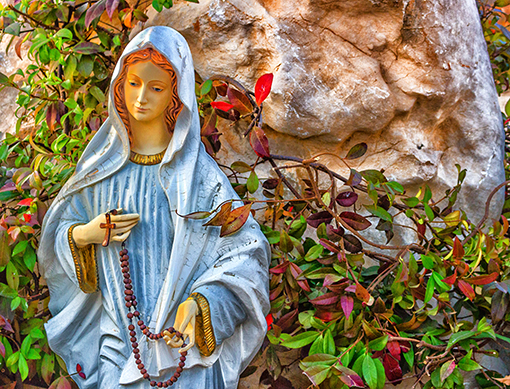Ever since I was a child, I’ve been fascinated by plants that grow in the most unexpected places, like the tree that grew up in the 1-inch metal pole of a stop sign on our corner and got big enough to provide a bit of shade until someone decided to cut the branches off.
 Or the little tree that grew between two panes of glass in our family room window. One pane was cracked (for a long time) and a seed found its way in and grew quite large until we could finally replace the window.
Or the little tree that grew between two panes of glass in our family room window. One pane was cracked (for a long time) and a seed found its way in and grew quite large until we could finally replace the window.
I recently found a small blooming flower growing out of a missing screw hole along the ground in the shopping cart return at the supermarket. It was lovely, a stark contrast to the paved parking lot with no growth in sight. And who hasn’t marveled at the flowering treasures that routinely grow up in the cracks of even the most well-traveled pavement?
These finds always remind me of the persistence of new life. They are hopeful and encouraging, something we need especially when times are difficult.
Perhaps that’s why I am so fond of Mary Gardens. With May being the month of Mary, and falling within the Easter season, the seasons of resurrection and new life, Mary Gardens provide the perfect opportunity for a faith lesson that remains visible for a good part of the year (depending on your climate).
Mary Gardens have been traced back to medieval times when flowers took on significance as symbols of Mary’s life and attributes. Gardens were created to honor Mary by gathering together those flowers around a focal point in the garden, most often a statue of Mary.
Some schools and parishes may already have a Mary Garden, but there is no reason why a smaller, more compact version can’t be creatively added to a classroom – in a corner, on a windowsill, or as part of the prayer table, using potted plants or even a small container garden.
This shortlist of Mary flowers is a start for picking flowers for your Mary Garden. Even one plant, such as an indoor rose, placed by a statue of Mary is enough to remind children daily of our relationship with the Mother of God.
During May, the garden may serve as a focus for prayers at the start and close of the school day should and include Marian prayers. Students may be assigned on a rotating schedule to care for the garden.
Lily – Perhaps the most well-known of Mary’s flowers, the lily, known as Madonna Lily, symbolizes Mary’s purity. The Angel Gabriel is often depicted at the Annunciation with a lily in hand. The lily, also known as the “Easter lily,” has the most significance as a symbol of new life during the Easter season because it grows from a bulb in the cold earth (tomb) and rises to be reborn as Christ rose from the dead.
Rose – Is symbolic of Mary under her title of Mystical Rose. There are many legends of Mary associated with roses. Also, the Rosary is sometimes made with rosebuds or represented in art as a garland of rose which sometimes adorns the Blessed Mother.
Iris – Known as the “sword lily’ most likely because of the blade-shaped foliage, which symbolized the sorrows that ‘pierced her heart.’ It is related to Mary as Our Lady of Sorrows.
Marigold – Known as “Mary’s Gold” by early Christians who placed the flowers around statues of Mary in place of coins. A legend shares the Holy Family’s flight into Egypt where they ran into a band of thieves who took Mary’s purse. When they opened it, marigold blossoms fell out.
Violet – Known as “Our Lady’s Modesty,” the flower is said to have blossomed when Mary said, “I am the handmaid of the Lord,” to the Angel Gabriel.
To learn more about Marian traditions under more than a dozen of her many titles, check out RCL Benziger’s Our Family Devotions: Popular Devotions from Around the World. It’s a great resource for classrooms, too.
The University of Dayton Marian Library has a wealth of resources on Mary Gardens for those who would like more information.
 About the Author
About the AuthorMary Regina Morrell, mother of six and grandmother to nine, is a Catholic journalist, author, and syndicated columnist who has served the dioceses of Metuchen and Trenton, New Jersey, and RENEW International in the areas of catechesis and communication.
